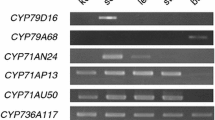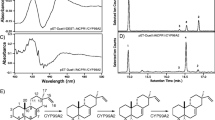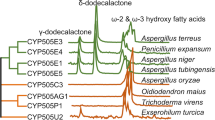Abstract
A cDNA encoding the multifunctional cytochrome P450, CYP71E1, involved in the biosynthesis of the cyanogenic glucoside dhurrin from Sorghum bicolor (L.) Moench was isolated. A PCR approach based on three consensus sequences of A-type cytochromes P450 – (V/I)KEX(L/F)R, FXPERF, and PFGXGRRXCXG – was applied. Three novel cytochromes P450 (CYP71E1, CYP98, and CYP99) in addition to a PCR fragment encoding sorghum cinnamic acid 4-hydroxylase were obtained.
Reconstitution experiments with recombinant CYP71E1 heterologously expressed in Escherichia coli and sorghum NADPH–cytochrome P450–reductase in L-α-dilaurylphosphatidyl choline micelles identified CYP71E1 as the cytochrome P450 that catalyses the conversion of p-hydroxyphenylacetaldoxime to p-hydroxymandelonitrile in dhurrin biosynthesis. In accordance to the proposed pathway for dhurrin biosynthesis CYP71E1 catalyses the dehydration of the oxime to the corresponding nitrile, followed by a C-hydroxylation of the nitrile to produce p-hydroxymandelonitrile. In vivo administration of oxime to E. coli cells results in the accumulation of the nitrile, which indicates that the flavodoxin/flavodoxin reductase system in E. coli is only able to support CYP71E1 in the dehydration reaction, and not in the subsequent C-hydroxylation reaction.
CYP79 catalyses the conversion of tyrosine to p-hydroxyphenylacetaldoxime, the first committed step in the biosynthesis of the cyanogenic glucoside dhurrin. Reconstitution of both CYP79 and CYP71E1 in combination with sorghum NADPH-cytochrome P450–reductase resulted in the conversion of tyrosine to p-hydroxymandelonitrile, i.e. the membranous part of the biosynthetic pathway of the cyanogenic glucoside dhurrin. Isolation of the cDNA for CYP71E1 together with the previously isolated cDNA for CYP79 provide important tools necessary for tissue-specific regulation of cyanogenic glucoside levels in plants to optimize food safety and pest resistance.
Similar content being viewed by others
References
Bak S, Kahn RA, Olsen CE, Halkier BA: Cloning and expression in Escherichia coli of the obtusifoliol 14α-demethylase of Sorghum bicolor (L.) Moench, a cytochrome 450 orthologous to the sterol 14α-demethylases (CYP51) from fungi and mammals. Plant J 11: 191–201 (1997).
Barnes HJ: Maximizing expression of eukaryotic cytochrome P450s in Escherichia coli. Meth Enzymol 272: 3–14 (1996).
Boucher J, Delaforge M, Mansuy D: Dehydration of alkyl-and arylaldoximes as a new cytochrome P450-catalyzed reaction: mechanism and stereochemical characteristics. Biochemistry 33: 7811–7818 (1994).
Christoffersen RE, Percival FW, Bozak KR: Functional and DNAsequence divergence of the CYP71 gene family in higher plants. Drug Metabol Drug Interact 12: 207–221 (1995).
Davis RH, Nahrstedt A: Biosynthesis of cyanogenic glucosides in butterflies and moths. Effective incorporation of 2-methylpropanenitrile and 2-methylbutanenitrile into linamarin and lotaustraline by Zygaena and Heliconius species (Lepidoptera). Insect Biochem 17: 689–693 (1987).
DeMaster EG, Shirota FN, Nagasawa HT: A Bechmann-type dehydration of n-bytyraldoxime catalyzed by a cytochrome P-450. J Org Chem 57: 5074–5075 (1992).
Dong M, Yamazaki H, Guo Z, Guengerich FP: Recombinant human cytochrome P450 1A2 and an N-terminaltruncated form: construction, purification, aggregation properties, and interaction with flavodoxin, ferredoxin, and NADPHcytochrome P450 reductase. Arch Biochem Biophys: 327, 11–19 (1996).
Durst F, Nelson DR: Diversity and evolution of plant P450 and P450-reductases. Drug Metabol Drug Interac 12: 189–206 (1995).
Fling SP, Gregerson DS: Peptide and protein molecular weight determination by electrophoresis using high-molarity Tris buffer without urea. Anal Biochem 155: 83–88 (1986).
Frey M, Chromet P, Glawischnig E, Stettner C, Grün S, Winklmair A, Eisenreich W, Bacher A, Meeley RB, Briggs SP, Simcox K, Gierl A: Genetic and biochemical analysis of a general plant defence mechanism in grasses. Science 277: 696–699 (1997).
Halkier BA, Nielsen HL, Koch BM, Møller BL: Purification and characterization of recombinant cytochrome P450tyr expressed at high levels in Escherichia coli. Arch Biochem Biophys 322: 369–377 (1995).
Halkier BA, Møller BL: Biosynthesis of the cyanogenic glucoside dhurrin in seedlings of Sorghum bicolor (L.) Moench and partial purification of the enzyme system involved. Plant Physiol 96: 10–17 (1989).
Halkier BA, Møller BL: The biosynthesis of cyanogenic glucosides in higher plants. Identification of three hydroxylation steps in the biosynthesis of dhurrin in Sorghum bicolor (L.) Moench and the involvement of 1-aci-nitro-2-(phydroxyphenyl) ethane as an intermediate. J Biol Chem 265: 2114–21121 (1990).
Halkier BA, Olsen CE, Møller BL: The biosynthesis of cyanogenic glucosides in higher plants. The (E)-and (Z)-isomers of p-hydroxyphenylacetaldehyde oxime as intermediates in the biosynthesis of dhurrin in Sorghum bicolor (L.) Moench. J Biol Chem 264: 19487–19494 (1989).
Holton TA, Brugliere F, Lester DR, Tanaka Y, Hyland CD, Menting J GT, Lu CY, Farcy E, Stevenson T W, Cornish EC: Cloning and expression of cytochrome P450 genes controlling flower colour. Nature 366: 276–279 (1993).
Holzkamp G, Nahrstedt A: biosynthesis of cyanogenic glucosides in the Lepidoptera: Incorporation of (U-14C)-2-methylpropanealdoxime, 2S-(U-14C)-methylbutanealdoxime and D,L-(U-14C)-N-hydroxyisoleucine into linamarin and lotaustraline by the larvea of Zygaena trifolii. Insect Biochem Mol Biol 24: 161–165 (1994).
Hösel W, Schiel O: Biosynthesis of cyanogenic glucosides: in vitro analysis of the glucosylation step. Arch Biochem Biophys 229: 177–186 (1984).
Imai Y, Sato R: Conversion of P-450 to P-420 by neutral salts and some other reagents. Eur J Biochem 1: 419–426 (1964).
Jenkins CM, Waterman MR: Flavodoxin and NADPH-flavodoxin reductase from Escherichia coli support bovine cytochrome P450c17 hydroxylase activities. Biochem J 269: 27401–27408 (1994).
Kahn RA, Bak S, Svendsen I, Halkier BA, Møller BL: Isolation and reconstitution of cytochrome P450ox, and in vitro reconstitution of the entire biosynthetic pathway of the cyanogenic glucoside dhurrin from Sorghum bicolor. Plant Physiol 115: in press (1997).
Koch BM, Sibbesen O, Halkier BA, Svendsen I, Møller BL: The primary sequence of cytochrome P450tyr, the multifunctional N-hydroxylase catalyzing the conversion of L-tyrosine to p-hydroxyphenylacetaldoxime in the biosynthesis of the cyanogenic glucoside dhurrin in Sorghum bicolor (L.) Moench. Arch Biochem. Biophys 32: 177–186: (1995).
Kraus PFX, Kutchan TM: Molecular cloning and heterologous expression of a cDNA encoding berbamunine synthase, a CO phenol-coupling cytochrome P450 from the higher plant Berberis stolonifera. Proc Natl Acad Sci USA 92: 2071–2075 (1995).
Mederacke H, Selmar D, Biehl B: Glucosyltransferases of the cyanogenic plant cassava (Manihot esculenta, Crantz). Angew Bot 69: 119–124 (1995).
Meijer AH, Souer E, Verpoorte R, Hoge JHC: Isolation of cytochrome P-450 cDNA clones from the higher plant Cataranthus roseus by a PCR strategy. Plant Mol Biol 22: 379–383 (1993).
Meyer K, Cusumano JC, Somerville C, Chapple CC: Ferulate-5-hydroxylase from Arabidopsis thaliana defines a new family of cytochrome P450-dependent monooxygenases. Proc Natl Acad Sci USA 93: 6869–6874 (1996).
Mitzutani M, Ward E, DiMaio J, Ohta D, Ryals J, Sato R: Molecular cloning and sequencing of a cDNA encoding mung bean cytochrome P450 (P450C4H) possessing cinnamate 4-hydroxylase activity. Biochem Biophys Res Comm 190: 875–880 (1993).
Møller BL, Poulton P: Cyanogenic glucosides. Meth Plant Biochem 9: 183–207 (1993).
Møller BL, Conn EE: The biosynthesis of cyanogenic glucosides in higher plants. Channelling of intermediates in dhurrin biosynthesis by a microsomal enzyme system from Sorghum bicolor (L.). J Biol Chem 255: 3049–3056 (1980).
Nahrstedt A: Cyanogenic glucosides as protecting agents for organisms. Plant Syst Evol 150: 35–47 (1985).
Omura T, Sato R: The carbon monoxide-binding of liver proteins. II. Solubilization, purification, and properties. J Biol Chem 239: 2379–2385 (1964).
Poulton JE: Cyanogenesis in plants. Plant Physiol 94: 401–405 (1990).
Reay PF, Conn EE: The purification and properties of uridine diphosphate glucose: aldehyde cyanohydrin β-glucosyltransferase from sorghum seedlings. J Biol Chem 249: 5826–5830 (1974).
Rosling H: Toxicity and food security: a review of the health effects of cyanide exposure from cassava and ways to prevent these effects, pp. 1–40. UNICEF, United Nations (1988).
Sambrook J, Fitsch EF, Maniatis T: in Molecular Cloning: A Laboratory Manual, 2nd ed. Cold Spring Harbor Laboratory Press, Cold Spring Harbor, NY (1989).
Schuler MA: Plant cytochrome P450 monooxygenases. Crit Rev Plant Sci 15: 235–284 (1996).
Sibbesen O, Koch B, Halkier BA, Møller BL: Cytochrome P450tyr is a multifunctional heme-thiolate enzyme catalyzing the conversion of L-tyrosine to p-hydroxyphenylacetaldehyde oxime in the biosynthesis of the cyanogenic glucoside dhurrin in Sorghum bicolor (L.). J Biol Chem 270: 3506–3511 (1995).
Sibbesen O, Koch BM, Halkier BA, Møller BL: Isolation of the heme-thiolate enzyme cytochrome P450tyr, which catalyzes the committed step in the biosynthesis of the cyanogenic glucoside dhurrin in Sorghum bicolor (L.) Moench. Proc Natl Acad Sci USA 91: 9740–9744 (1994).
Wada A, Mathew PA, Barnes HJ, Sanders D, Estabrook RW, Waterman MR: Expression of functional bovine cholesterol side chain cleavage cytochrome P450 (P450scc) in Escherichia coli. Arch Biochem Biophys 290: 376–380 (1991).
Yamazaki S, Sato K, Suhura K, Sakaguchi M, Mihara K, Omura T: Importance of the proline-rich region following signal-anchor sequence in the formation of correct conformation of microsomal cytochromes P-450. J Biol Chem 114: 652–657 (1993).
Author information
Authors and Affiliations
Rights and permissions
About this article
Cite this article
Bak, S., Kahn, R.A., Nielsen, H.L. et al. Cloning of three A-type cytochromes P450, CYP71E1, CYP98, and CYP99 from Sorghum bicolor (L.) Moench by a PCR approach and identification by expression in Escherichia coli of CYP71E1 as a multifunctional cytochrome P450 in the biosynthesis of the cyanogenic glucoside dhurrin. Plant Mol Biol 36, 393–405 (1998). https://doi.org/10.1023/A:1005915507497
Issue Date:
DOI: https://doi.org/10.1023/A:1005915507497




